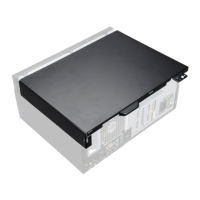Table 4. Navigation keys
Keys Navigation
Up arrow Moves to the previous field.
Down arrow Moves to the next field.
Enter Allows you to select a value in the selected field (if applicable) or follow the link in
the field.
Spacebar Expands or collapses a drop‐down list, if applicable.
Tab Moves to the next focus area.
NOTE: For the standard graphics browser only.
Esc Moves to the previous page till you view the main screen. Pressing Esc in the main
screen displays a message that prompts you to save any unsaved changes and
restarts the system.
F1 Displays the System Setup help file.
System Setup options
NOTE: Depending on the computer and its installed devices, the items listed in this section may or
may not appear.
Table 5. General
Option Description
System Information Displays the following information:
• System Information: Displays BIOS Version, Service Tag, Asset Tag,
Ownership Date, Manufacture Date, and the Express Service Code.
• Memory Information: Displays Memory Installed, Memory Available,
Memory Speed, Memory Channels Mode, Memory Technology, DIMM 1
Size,, DIMM 2 Size, DIMM 3 Size, and DIMM 4 Size.
• PCI Information: Displays SLOT1, SLOT2, SLOT3, SLOT4, and SLOT5_M.
2
• Processor Information: Displays Processor Type, Core Count, Processor
ID, Current Clock Speed, Minimum Clock Speed, Maximum Clock
Speed, Processor L2 Cache, Processor L3 Cache, HT Capable, and 64-
Bit Technology.
• Device Information: Displays SATA-0, LOM MAC Address, Video
Controller, Audio Controller, Wi-Fi Device, and Bluetooth Device.
Boot Sequence
Allows you to specify the order in which the computer attempts to find an
operating system from the devices specified in this list.
• Legacy
• UEFI
Advanced Boot Options Allows you to select the Enable Legacy Option ROMs option, when in UEFI
boot mode. By default, this option is enabled.
Date/Time Allows you to set the date and time settings. Changes to the system date
and time take effect immediately.
37

